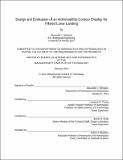Design and evaluation of an achievability contour display for piloted lunar landing
Author(s)
Stimpson, Alexander J. (Alexander James)
DownloadFull printable version (3.707Mb)
Other Contributors
Massachusetts Institute of Technology. Dept. of Aeronautics and Astronautics.
Advisor
Laurence R. Young and Kevin R. Duda.
Terms of use
Metadata
Show full item recordAbstract
Landing on the moon requires the selection and identification of a location that is level and free of hazards, along with a stable, controlled descent to the lunar surface through the use of automated systems and manual control. Spatial disorientation may occur upon reentering a gravitational field after vestibular adaptation to microgravity during lunar transit. The workload associated with selecting a suitable landing point based on the remaining fuel and current vehicle states is a concern. In Apollo, visual out-the-window information was heavily relied upon to support the selection of a landing point, and there was little support information available to indicate whether the desired site was achievable. A novel achievability contour display element showing the dynamic achievable landing area was developed based on a Goal-Directed Task Analysis and usability testing. A subject experiment was conducted in a lunar landing simulation environment to test the effects of the achievability contour on pilot performance, situation awareness, and workload in simulated approach and terminal descent scenarios as compared to an Apollo-style auditory display. Two control modes were used: supervisory control and roll, pitch, and yaw rate-control/attitude-hold (RCAH) manual control. The experiment also investigated differences in display effect with and without a required redesignation. Results of the subject experiment (N = 10) indicate that the achievability contour display showed significant improvement in subjective situation awareness and workload ratings. The results also indicate a change in decision-making behavior with the use of the achievability contour display. There was no measurable difference in flight and landing performance measures between the two display conditions. The results of the experiment suggest that providing the achievability contour display may have beneficial effects on pilot situation awareness and workload during the final approach and terminal descent maneuvers. Additional research is needed to determine the optimal implementation and pilot interaction methods in the use of this display.
Description
Thesis (S.M.)--Massachusetts Institute of Technology, Dept. of Aeronautics and Astronautics, 2011. Cataloged from PDF version of thesis. Includes bibliographical references (p. 81-83).
Date issued
2011Department
Massachusetts Institute of Technology. Department of Aeronautics and AstronauticsPublisher
Massachusetts Institute of Technology
Keywords
Aeronautics and Astronautics.